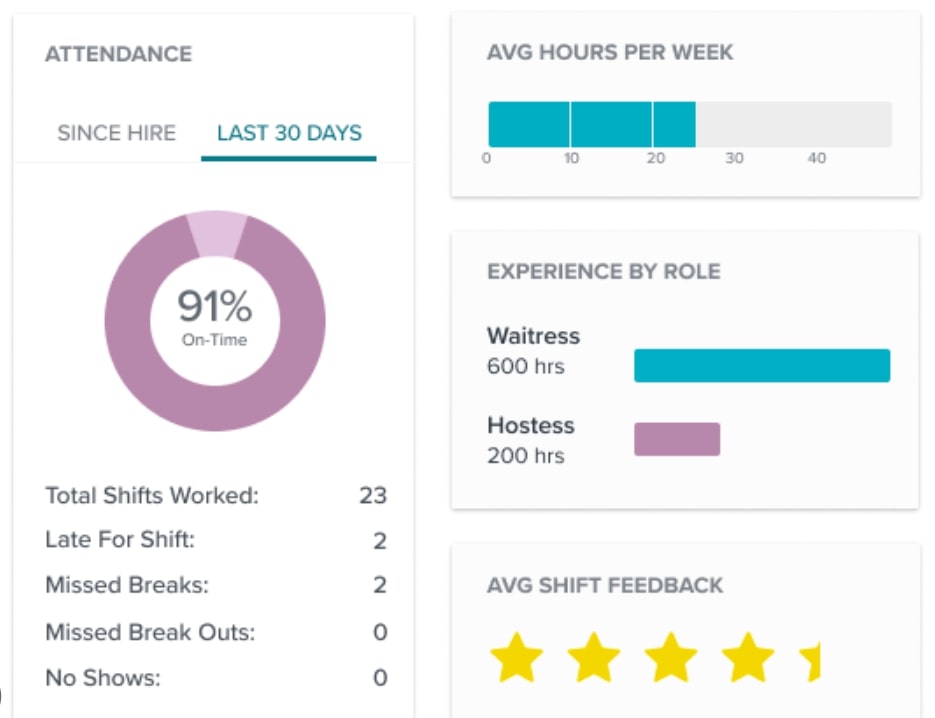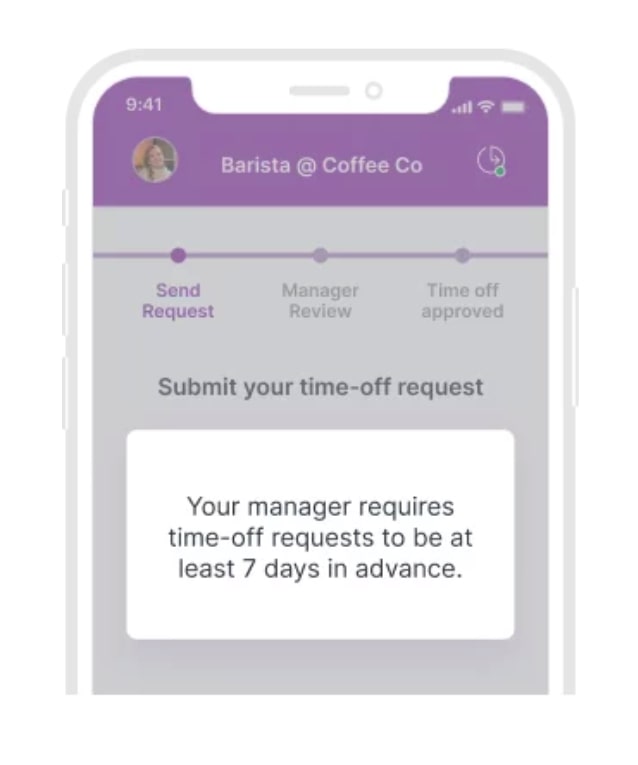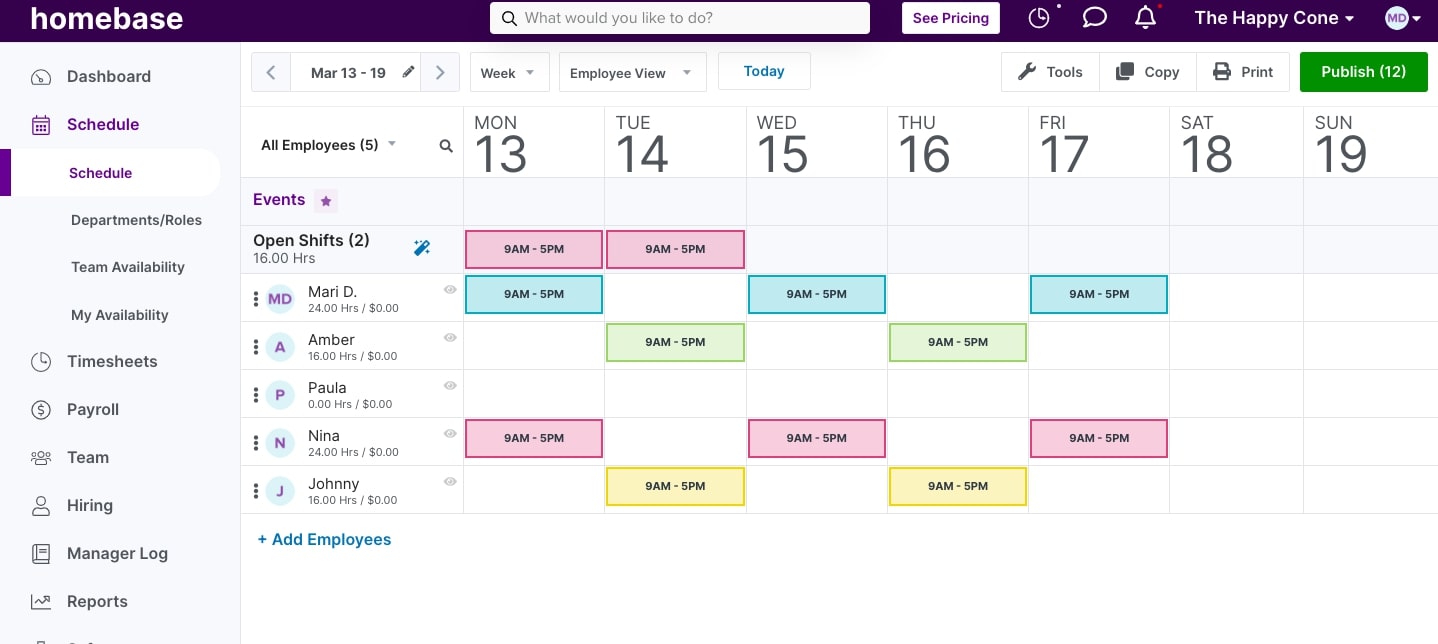*Gallup-Sharecare Well-Being Index, 2021
Understanding employee absenteeism
Employee absenteeism happens when team members don’t show up to their scheduled shifts on a consistent basis. Businesses tend to account for some absences every year due to illness, personal time, and vacation. But it becomes an issue when it happens unexpectedly and frequently, affecting other team members’ ability to do their jobs.
It’s helpful to define different types of absences for your workplace because the unpredictable happens to everyone. Employees deserve some flexibility and understanding, even if they aren’t able to give you much notice or warning that they’ll be absent. Types of absences include:
- Scheduled and planned absences — These may include vacation, personal time, time off for appointments, or parental leave. The employer is able to plan ahead and schedule other team members to fill in for their absent coworkers.
- Legitimate unplanned absences — In cases of sudden illness, family members getting sick, or accidents, these missed days are acceptable. Employers should never penalize team members for absences of this nature, although they may cause scheduling issues.
- Unapproved absences — When employees don’t give notice and don’t get permission to take time off, it can cause serious disruptions with work and other team members’ schedules. In these cases, employers should have a discussion with the staff member to identify any underlying reasons and prevent unapproved absences in the future.
Common causes of employee absenteeism

Knowing the typical factors that contribute to high staff absence rates can help you create sick leave policies and workplace procedures that truly accommodate employees’ needs. Causes include:
- Health problems and disabilities — Chronic illnesses, injuries, and disabilities can lead to an increase in employees missing work, especially when their workplace isn’t accessible to them and other workers don’t take precautions to protect their teammates from getting sick.
- Mental health issues — Depression is a major cause of employee absences in the US, and it can exacerbate symptoms of stress, burnout, and other physical health issues.
- Sick family members — Working parents or people who take care of aging family members may often miss work when their loved ones fall ill.
- Childcare issues — Sometimes childcare falls through due to unforseen circumstances. When that happens, parents have to take extra time off with little notice until they find temporary help.
- Burnout — This is more than stress. It’s a combination of emotional, mental, and physical exhaustion caused by prolonged stress and overwork. It’s such a serious and widespread issue that the World Health Organization has included it in its International Classification of Diseases.
- Harassment — Employees that suffer from bullying or mistreatment at the hands of their coworkers or managers may need time away from an unhealthy environment, resulting in a high number of absences.
The impact of employee absences on businesses
Absenteeism affects everyone — business owners, staff, and customers. And it can be hard to recover from its consequences. In light of this, let’s explore a few specific ways absences impact businesses:
- Increased workload for coworkers — When absences are unplanned and unapproved, it leaves other team members to pick up the slack. So, for example, a server during a busy dinner rush may have to take care of their absent teammate’s tables even if they’re already swamped with their own.
- Decreased morale — As time goes on, staff may begin to feel they’re being taken advantage of and feel resentment towards the additional workload. They might even begin to assume their managers are at fault for not finding a replacement.
- Decline in performance — It’s harder for employees to be as attentive and detail-oriented with their tasks when they’ve taken on more work than they have capacity for.
- Reduced productivity — You’ll likely be rescheduling important team meetings and delaying tasks until the team member returns. On top of that, you may have to set aside current business priorities to redistribute work and employee timetables.
- Lower profitability — Your team might not be able to handle as many transactions and sales if you’re understaffed due to absenteeism, possibly resulting in a loss of customers.
- Loss in revenue — If you have salaried workers, paying absent team members means you’re not getting a return on your investment. Reduced productivity and sales can also translate into a dip in income.

Measuring employee absenteeism
If you’re concerned that absenteeism is too complex to monitor, don’t worry. There’s a basic formula you can use to make sure absenteeism isn’t impacting your business called absentee rate. This tells you the percentage of time employees have missed in a given period.
We’ll show you step-by-step how to calculate your absentee rate using the example of Mary, who has missed four days in the last month out of a scheduled 25.
- Divide the number of missed days by the total number of scheduled days. (4 / by 25 0.16).
- Multiply your absentee rate by 100 to get your percentage. (0.16 x 100 = 16%).
- 16% is your absentee rate for Mary.
For a good benchmark, an acceptable absentee rate in a year is around 1.5% percent according to the Bureau of Labor Statistics. Last year’s total absence rate in the US was around 3.6%.
Manual time tracking methods are enough to help you calculate your absentee rates, but it takes time to add up your total absences and do the math on your own.
This is where a platform like Homebase is handy. Our free employee time clock integrates with reporting tools so you can track late clock-ins, missed breaks, and no-shows, and then you can follow up with team members about any issues using our team messaging feature. Our reporting feature also lets you compare scheduled hours versus actual hours worked over the past week or month so you can quickly spot any downward trends in attendance.

Strategies for managing employee absenteeism
If you’ve got too many employees who aren’t showing up for work consistently, it might be time to make changes to your current policies, procedures, and work culture. Here are a few strategies you can implement to lower your absentee rates.
Promote work-life balance
Fostering a healthy work-life balance for your team is about empowering everyone to communicate their boundaries and address workplace issues. Employees shouldn’t feel scared to ask for help, ask questions, or suggest improvements.
You should also outline your absenteeism and time off policies clearly in your employee handbook so that staff members don’t feel pressured to work outside regular hours or put in overtime.
Finally, make sure employees take time off so they can recharge and prevent exhaustion. Keep an eye on how many days each team member has taken for vacation or personal time off (PTO), and nudge anyone who hasn’t had a break from work in a while.
And if your current time off management process is too complicated, it’s time for a tool like Homebase. Team members can make PTO requests straight from the mobile app for managers to review. Plus, you can set up custom PTO rules ahead of time to prevent anyone from making requests without due notice.

Provide flexible schedules
Scheduling is a challenge when you’re working to accommodate everyone’s availability. But giving employees flexibility pays off when they can organize their working hours around their personal lives and avoid burnout.
That’s why we recommend using Homebase’s free scheduling tool to coordinate with your team’s preferences and needs. You won’t have to stress about running into conflicts with staff members’ availability: they enter their preferred hours and days in the platform, and it automatically stops you from assigning them shifts they can’t work. And if you have open shifts due to planned absences, you can post them above the schedule for anyone free to claim.

Address health and wellness issues
You can’t predict every wellness issue your employees will have. But you can create a workplace where team members don’t work when they’re sick, aren’t afraid to talk about mental health, and feel comfortable and happy coming to work every day. Here are a few suggestions to make that a reality:
- Never pressure employees to work when they’re ill — This isn’t just about giving a sick employee ample time to recuperate; it’s also vital to preventing the spread of illness in your workplace.
- Encourage mental health days — When you notice an employee may be going through a tough time or is getting overworked, invite them to take a sick day to recover.
- Make sure employees know how to request workplace accommodations — Employees may be afraid to ask for assistance out of fear of being judged or treated unfairly. That’s why your employee handbook should clearly explain how team members can ask for services like assistive technologies, flexible work arrangements, sensory support, and mobility aids.
- Establish a zero-tolerance policy for discrimination and harassment — Follow Equal Employment Opportunity Commission (EEOC) guidelines, which make it illegal to harass or mistreat employees based on age, disability, national origin, race, sex, or gender identity.
Get help from human resources
Human resource (HR) professionals play a crucial role in monitoring and managing absenteeism. It’s typically their responsibility to develop and update absence policies, address issues as they arise, and provide support for employees who may be struggling with workplace stress, childcare, or health issues. But what do you do if you’re a small business owner who doesn’t have HR help and has no experience with HR?
That’s where a platform like Homebase will help. Our on-call team of HR professionals is available to review your policies, answer your questions, and even create a customized employee handbook for your small business. You’ll also get access to an extensive library of HR training materials, templates, and guides to keep on hand.
Use Homebase and don’t let absences get the best of you
Absenteeism can have a significant impact on your team’s stress levels, productivity, morale — and your business’s bottom line. But creating a supportive work culture can prevent absentee issues from taking hold.
And you don’t have to do it all on your own — you can use team management tools to create flexible schedules, easily track absences and time off, and communicate with team members when conflicts arise.
Let Homebase be your partner in team management. With our suite of tools for scheduling, time tracking, hiring and onboarding, team messaging, and HR and compliance, you’ll have everything you need to manage an hourly staff that enjoys coming to work every day.
